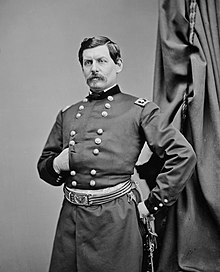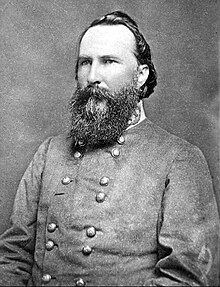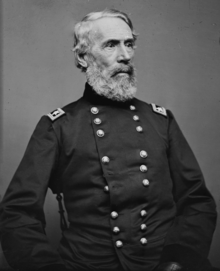Battle of Glendale
| date | June 30, 1862 |
|---|---|
| place | Hanover and Henrico Countys , Virginia , USA |
| output | undecided battle |
| Parties to the conflict | |
|---|---|
| Commander | |
| Troop strength | |
|
about 40,000
|
about 70,000
|
| losses | |
|
3,797 killed
: 297 wounded: 1,696 missing / captured: 1,804 |
3,673 killed
: 638 wounded: 2,814 missing / captured: 221 |
The Battle of Glendale , also known as the Battle of Frayser's Farm , took place at the same time as the battle at White Oak Swamp on June 30, 1862 in Virginia. It was a meeting of the Seven Day Battle during the Peninsula Campaign . The concentric attacks of the Confederate on a broad front were divided into several partial battles, which is why the battle is also known under other names as the battle at Nelson's Farm, Charles City Crossroads, Riddell's Shop or on New Market Road. General Robert E. Lee's attempt to attack the Potomac Army with 7 divisions , which was evading to the south-east to James , and to destroy it in a " Cannae ", failed because of a lack of coordination among the major units and poor staff work. Only two of the Confederate divisions destined for attack were in contact with the enemy. The rearguard of the Potomac Army under Maj. Gen. William B. Franklin managed to stop Maj. General "Stonewall" Jackson's divisions at the bridge over the White Oak. Fighting further southwest at the hamlet of Glendale began in the early afternoon and continued well into the night. The Union troops were not defeated, but still avoided safe positions on Malvern Hill.
prehistory
The seven-day battle began on June 25 with the attack by the Potomac Army under Major General George B. McClellan on Oak Grove . The next day, the Northern Virginia Army under General Lee began a series of counter attacks. When the danger of outflanking the US Corps became apparent, McClellan moved the supply base to Harrisons Landing on the James. He intends to go there with his five corps, constantly fighting under the protection of the gunboats lying there.
Operation plan
General Lee intended to outflank the Potomac Army east of Richmond on both flanks before they could reach the James. At Glendale a number of roads crossed which Union forces had to use. Jackson was to attack the extreme right wing of the Potomac Army from the north with 25,000 men and with 45,000 men Lee wanted to break into the Union positions in the middle near Glendale with three divisions and in the south with a division to seal off the evasion to the south.
McClellan inspected the sequence of evasive movements on the morning of June 30th and then went aboard the USS Galena without appointing someone responsible for coordination on the battlefield or having coordinated the evasive movements in detail himself. The bulk of V Corps Brigadier General Porters occupied the key area of Malvern Hill, the other four corps operated largely independently and without coordinating their constantly fighting evasions. A third of the Potomac Army had already reached their positions at Harrisons Landing.
Starting position
The VI. Brigadier General Franklin's Corps with 20,000 men and strong artillery support formed the right wing of the Potomac Army and, as rearguard, secured the passage over the swampy White Oak Creek. The lines of the Union troops had set up a strong defensive on both sides of the road to Richmond, about 40,000 men were concentrated in an arc to the west and south. In the center was the III. Corps under Brigadier General Samuel P. Heintzelman deployed with four divisions to protect Charles City Road. Behind them, the division under Brigadier General George A. McCall moved up between Riddell's shop and Frayser's farm. The southernmost division under Brigadier General Joseph Hooker had already reached Willis Church and was securing along the Quaker Road to the west parallel to the Western Run Bach.
Jackson's fight at White Oak Creek
General Thomas Jackson's corps (about 25,000 men) advanced from Savage's station to the White Oak Swamp on the morning of June 30th. He had orders to hold the Union's rearguard at the White Oak Swamp, it came with the rearguard of VI. Union Corps for artillery combat, while the actual main battle took place 3.2 kilometers south at Glendale. Due to resistance from Franklin's forces, Jackson's corps was prevented from effectively intervening in the battle. The march was slow because there were thousands of wounded Union prisoners in the train. The only bridge over the swamp had been burned two hours earlier by Union forces on Franklin's orders. At the head of the column was Jackson's artillery chief Colonel Stapleton Crutchfield. Seven batteries with 31 guns from Whiting's division opened fire at a distance of 270 meters against the rearguard of Franklin's batteries, which were protecting the south bank. Jackson commissioned the 2nd Virginia Cavalry Regiment under Colonel Thomas T. Munford with a nearby crossing to provide cover for the engineers in the reconstruction of a temporary bridge. Major General DH Hill crossed the river to personally conduct reconnaissance work, but strong Union artillery fire prevented further success. A quarter of a mile downstream a ford was identified as suitable for infantry, and Brigadier General Wade Hampton was to build a temporary bridge. The last Union units at White Oak Swamp consisted of the divisions of Brigadier Generals William F. Smith and Israel B. Richardson . While the artillery duel with 40 guns lasted and brought few losses, the Battle of Glendale raged less than three miles to the southwest. Jackson was unable to inform General Lee, who expected his intervention, of his stalemate. Although Jackson's troops held tens of thousands of soldiers from Franklin's Corps, there was no infantry fighting at White Oak Swamp, the section was limited to an artillery duel.
The battle
At 4:00 AM General Lee had ordered Major General Magruder to join Major General Theophilus Holmes in the Malvern Hills; however, the division faced Porter's troops all day only defensively. Holmes attacked the Union's left flank at Turkey Bridge, but was held down by artillery fire from the Union position on Malvern Hill and from the James River from the gunboats USS Galena and USS Aroostook . Jackson's forced inaction allowed two divisions of Franklin's corps to reinforce Union forces in the center at Glendale in the late afternoon. Three brigades under Brigadier General John Sedgwick were already approaching along Long Bridge Road into the center of the Battle of Glendale. The US McCall Division, also left in the center, had stopped marching south of the Charles City Crossroads to make a westward front. A strong Confederate division under Major General Huger attacked from the west along Charles City Road. After advancing 5 kilometers, this was stopped by trees felled across the street by pioneers of Slocums division. General Huger's forces could not find an alternative route and, like Jackson, could not intervene in the battle.
As planned, the divisions led by Major General AP Hill and James Longstreet carried out the main attack. They were about 40,000 Unionists of the II. And III. Corps on the front about two miles north and south of Glendale at the intersection opposite. The fight was later extended to 4.8 kilometers of the front. In the first meeting, three brigades attacked side by side, from north to south Brigadier Brigadier General Cadmus M. Wilcox , Colonel Micah Jenkins (Anderson Brigade) and Brigadier General James L. Kempers . In contrast, there were 6,000 men in the division under Brigadier General McCall, concentrated west of Nelson Farms to north of Willi's Church. - Brigadier General George G. Meade's brigade defended on the right and Brigadier General Truman Seymours on the left . Brigadier General John F. Reynolds ' brigade remained in reserve (in this battle led on behalf of Colonel Seneca G. Simmons).
General Kemper's Virginia regiments led a disorderly but enthusiastic attack through the thick woods and were covered by five batteries of McCalls division. Left supported Jenkins' brigade, while General Wilcox and his Alabama infantry could not intervene until a few hours later. General Sedgwick, whose brigades swung south from the White Oak Swamp to Quaker Road, filled a gap in the front in the main area of attack. His three brigades, Caldwel, Dana and Sully, lined up one after the other to defend Long Street's troops. General Meade was wounded in the fighting and General McCall was captured by Confederate patrols.
To the north of Charles City Road, the III. US Corps under General Samuel Heintzelman meet his division under Brigadier General Philip Kearny north of Riddell`s shop against the attack by the Confederate Brigade under General Pryor . On the southern flank of the front, a strong Union division under Brigadier General Joseph Hooker initially remained almost unmolested and only fought off minor attacks against the Brigade Branch behind the Western Run . In the afternoon, the Grover Brigade then carried out a strong flank attack against the CS Brigade under General Archer . At around 2 a.m. the Confederate line was heavily covered by the Union artillery: General AP Hill urged President Jefferson Davis and other high-ranking generals to move to the rear to be on the safe side. General Longstreet attempted to silence the six Union batteries by long-range artillery fire and ordered Colonel Micah Jenkins to shut down the enemy batteries.
The frontal battle only ended when darkness fell. Although the Longstreets and Hills troops had gained some ground, they had suffered heavy losses. Aside from Huger's and Magruder's failures, the planned intervention by Jackson's forces in the north never materialized and was a major reason the attacks were unsuccessful.
consequences
That night, the Potomac Army returned to the strong position prepared on Malvern Hill. The fight was tactically inconclusive for General Lee, but the attack also paralyzed the overly cautious General McClellan to counterattack. The Union had losses of 3,797 men (297 dead, 1,696 injured and 1,804 missing). The Confederates lost 3,673 soldiers (638 dead, 2,814 injured and 221 missing), and Longstreet alone lost more than a quarter of its division. Union Generals Meade and Sumner and Southern Generals Joseph R. Anderson , William Pender and Winfield S. Featherston were wounded in action.
In the Battle of Malvern Hill the following day, July 1, the Northern Virginia Army was clearly defeated. General McClellan, who nevertheless remained convinced of his inferiority, avoided Harrisons Landing, where he had moved his supply base in the previous days. From there he wanted to threaten Richmond again after the arrival of reinforcements. Even if Lee's ambitious plan did not succeed, he had succeeded in repelling the greatest threat from the northern states so far in the war.
literature
- Stephen W. Sears: Glendale - Opportunity Squandered. In: Keith Poulter: North and South, Volume 5, Number 1, December 2001, pp. 13-24.
- Stephen W. Sears: To the Gates of Richmond. The Peninsula Campaign. Ticknor and Fields, New York 1992.
- Brian K. Burton: Extraordinary Circumstances - The Seven Days Battles. Indiana University Press, Bloomington 2001.
- Clifford Dowdey: The Seven Days - The Emergence of Lee. University of Nebraska Press, Lincoln (Nebraska) 1993.
- Gary W Gallagher: The Richmond Campaign of 1862. The Peninsula and the Seven Days. University of North Carolina Press, Chapel Hill 2000.
Individual evidence
- ↑ a b losses. Virginia Foundation for the Humanities, accessed November 28, 2015 ( Encyclopedia Virginia , Battle of Glendale).
- ↑ a b James McPherson, Battle Cry of Freedom , p. 469
- ↑ Shelby Foote : The Civil War - A Narrative - Fort Sumter to Perryville . First Vintage Books Edition, New York 1986, ISBN 0-394-74623-6 , pp. 501 .
- ^ Sears: Glendale Journal Article, North and South , Volume 5, Number 1 Dec. 2001, pp. 13-24
- ↑ Bernd G. Längin: The American Civil War, Bechtermünz Verlag, Augsburg 1998, p. 110
Web links
- Battle of Frayser's Farm - Glendale on thomaslegion.net




